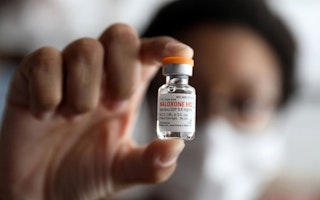Extreme Abuse in the Name of Drug “Treatment”
By Roxanne Saucier
If a group of men grab you off the street, call you a danger to society, and lock you in a “treatment” facility where you are beaten for trying to escape, who should protect you? This is one of the many troubling questions raised in a new report edited by the UN Special Rapporteur on Torture and funded by the Open Society Foundations.
Though human rights groups have criticized government-run drug detention centers for practices including forced labor and torture in countries in East and Southeast Asia, private centers—often run by vigilante groups or religious institutions—can be just as abusive. Accounts of life in these centers have also emerged from Russia and Serbia.
Even countries throughout Latin America—a region of the world has lately lauded for its increasingly progressive stance on drugs—allow these punitive institutions. Governments in these countries at best turn a blind eye, and at worst are complicit.
Here are four ways that these private detention centers violate individual rights in Latin America:
- Admission is often forced or coerced. Families often don’t know the bleak reality of conditions in the center, or see no other alternative for treatment. As one family member in Mexico said, “We took him there with the hope of rehabilitation, and that he would stop using drugs. We didn’t send him to get beaten up; that was never our aim.” In other cases, centers send volunteers out on “hunting parties” to essentially kidnap people on the streets who appear intoxicated. In some instances, police participate in roundups. When the “patients” arrive at the center, staff or volunteers from the centers often physically force them inside against their will.
- “Patients” are held against their will. People describe steel bars, razor wire, concrete walls topped with glass shards, and guards tasked with keeping them inside the centers. Adequate medical care may even be restricted due to worries about escape. Family visits are usually monitored and terms of “treatment” can be extended arbitrarily. One detainee in Guatemala complained, “My family brought me here. And, from what I know, the pastor has to tell my family that I’m ready to go. I don’t know [if] they will find a reason to keep me here, and every time I think I am ready, they change the game.”
- Torture passes for treatment. One detainee described the routine in the center where he was being held: “The head guy would put shoes on, tell us to lie down, and then run on top of us. Back and forth. Back and forth. After he would beat us, he would make us sleep on the stairs, in boxers. He called it discipline.” Detainees also report physical punishment for complaining about conditions or other behavioral infractions. In a Guatemalan center, for example, those who say, “I don’t like it,” are punished with 1,000 squats, as are those who “fail to love the Bible.” Swearing is punished with 1,000 squats per letter, "including the spaces.” Escape attempts are punished with 5,000 squats a day for eight days.
- People are dying in detention. In Peru, two fires in religious centers claimed the lives of those placed there for “rehabilitation”; detainees struggled against locked doors as they burned to death. In an account from Mexico, a sister described her brother’s death from the physical abuse he received by center personnel. There are likely many other similar cases that haven’t received widespread attention.
Even though many of these centers are run by private entities, it is the responsibility of governments to monitor them to ensure that abuses don’t happen. Unfortunately, governments are doing very little to prevent human rights violations in private centers, to sanction the facilities, or to punish those responsible.
In fact, many such centers are not even officially registered with government entities. For example the Peruvian agency responsible for drug prevention and treatment noted that of 222 “rehabilitation” facilities in the country, only 20 percent have all the necessary licenses and required medical staff. There are an estimated 700 “treatment” slots in registered facilities for an estimated 100,000 people in need. In Guatemala, there is reportedly one government worker responsible for visiting the hundreds of drug rehabilitation centers and accrediting them.
The United States is among those governments offering training to staff and assessment of drug treatment centers in an effort to improve conditions. But these efforts sidestep the critical issue that many people in these centers don’t actually need to be there. Many of them do not have a problematic dependence on drugs and are not clinically in need of treatment, or they are from other “socially undesirable” groups like homeless people, or those with disabilities, and shouldn’t be detained in the first place.
The answer isn’t to improve centers that hold people against their will. Instead, governments need to make evidence-based, voluntary treatment in their communities more available—and make sure that centers that repeatedly violate human rights are closed for good.
Roxanne Saucier is a researcher and analyst for the Open Society Public Health Program.


